Instant Pot Kare-Kare (Filipino Oxtail-Peanut Stew)
I can’t think of a single Filipino who doesn’t like kare-kare. This traditional peanut-based stew is a national favorite and now with the Instant Pot, this dish can be at the table in half the time.
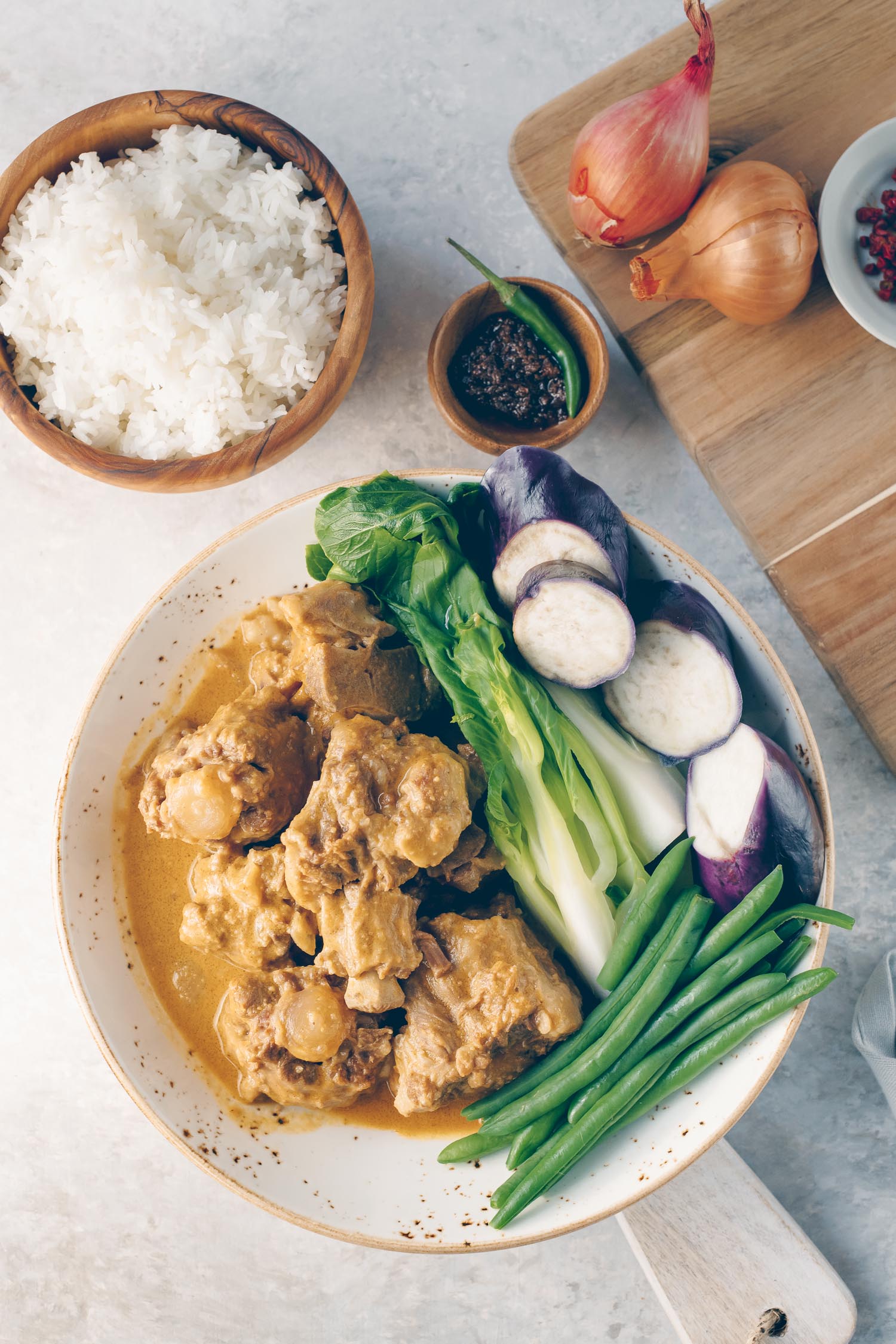
It might confuse (or annoy) some to have read my previous post describing my family’s plant-based journey only to be followed by a recipe for oxtail stew. I did mention that we are part-time vegetarians, making sure that our meals are meat-free for at least half of the week but we do still eat chicken and fish as part of our regular diet. Beef and pork are occasional treats and will continue to make an appearance on the blog, especially as I’ve been picking my mom’s brain with every phone conversation in an attempt to preserve in this blog some of my favorite Filipino recipes from my childhood. Kare-kare is one of these recipes.
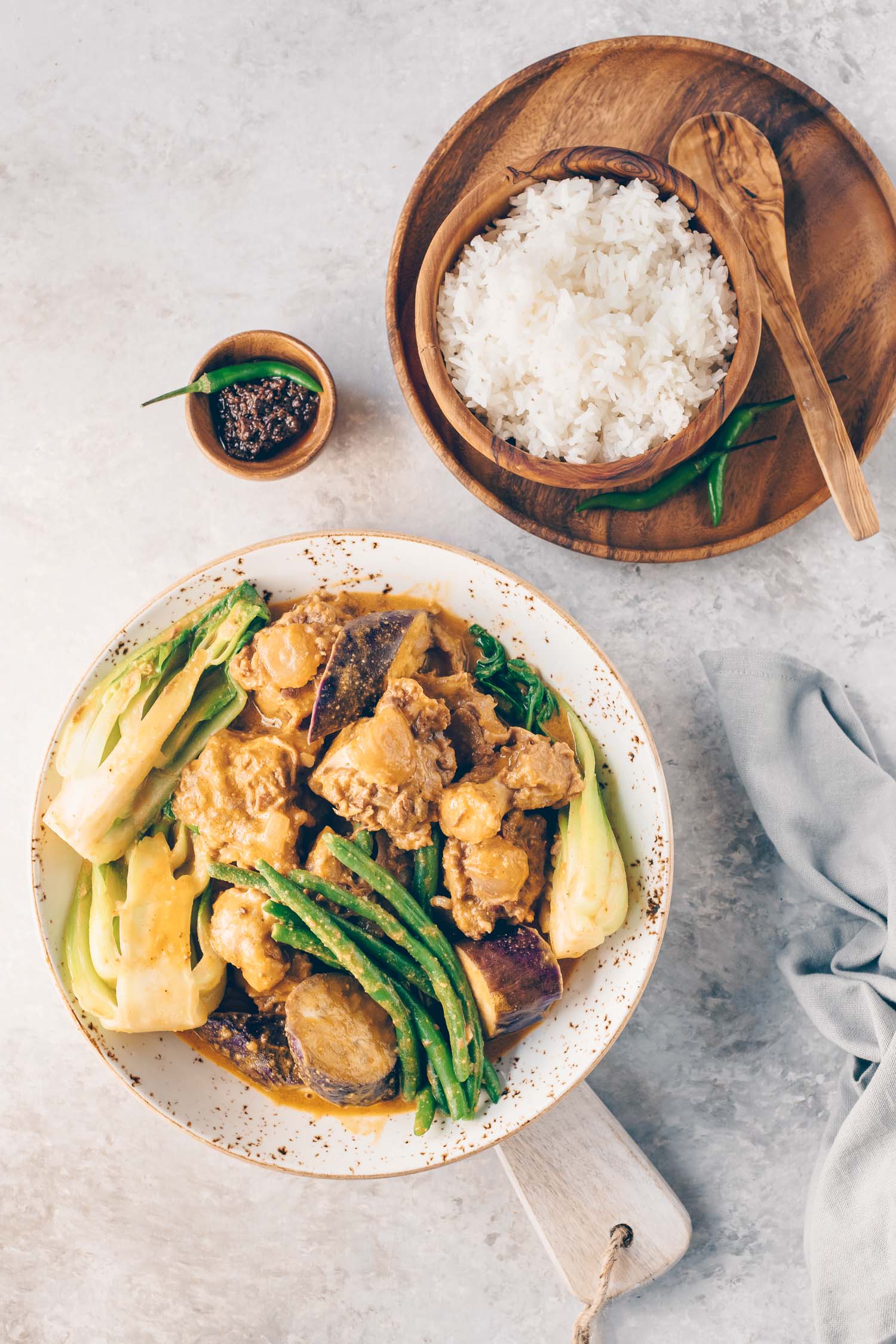
What is Kare-Kare?
Kare-kare (kuh-reh-kuh-reh) is a stew made with crushed peanuts and ground, toasted rice, traditionally prepared with oxtail and/or tripe. It’s a favorite of most–if not all–Filipinos and besides how tasty it is, its other noteworthy characteristic is that with the long cooking time required to tenderize the meat (and tripe), it’s a labor of love. Because of this, kare-kare is a weekend dish or one that is served at gatherings.
I couldn’t find anything definitive about the origins of kare-kare as being solely Filipino in roots and its similarity to maafe, a West African peanut-based stew, is hard to ignore.
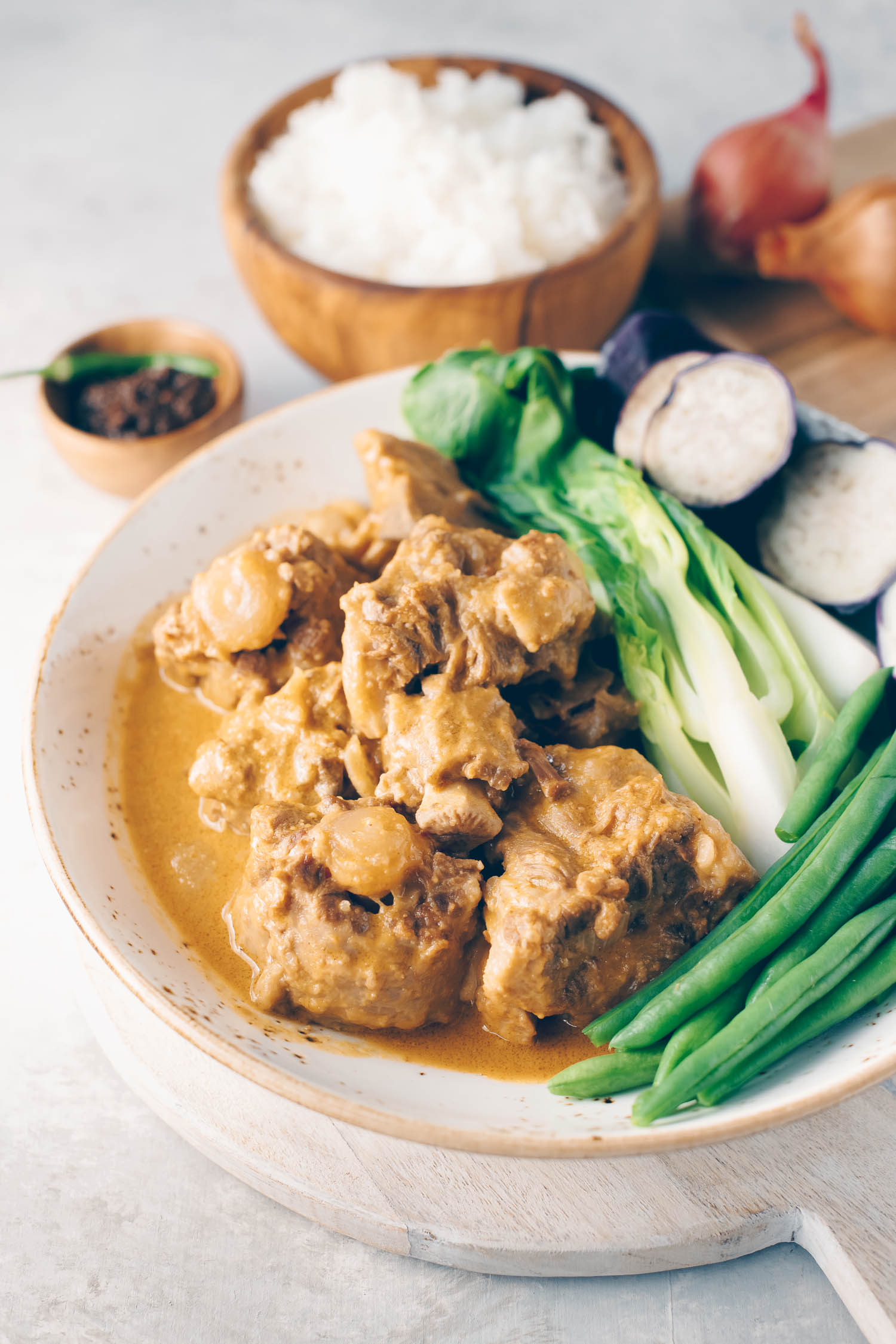
Kare-Kare: A Brief History
The Philippines and West Africa have a common denominator: Spanish colonial rule. Early explorations led the Spanish to South America where it is believed peanuts originated (specifically, Brazil and Peru). The first Spaniards setting foot on Western Africa date as far back as the 14th and 15th centuries, though colonization didn’t take place until the late 1700s and in the 1900s. In the Philippines 300 years of colonial rule started at the end of the 16th century. It’s hard to say which came first, the kare-kare or maafe and if kare-kare was adapted by the West Africans to become maafe or vice versa–but the Spanish introduced peanuts to both places and the two dishes must be related.

As is true for most Filipino dishes with Spanish roots, Filipinos have made kare-kare their own. Instead of okra, cabbage and tomatoes traditional with maafe, string beans, banana blossoms and eggplant are the vegetables used to round out kare-kare. Annatto seeds from the achiote plant are used to add rich color to the dish and since peanuts lend richness but not much umami, salty shrimp paste is a necessary component.
As I mentioned earlier, kare-kare is a labor of love. Oxtail and tripe can take at least two hours to become tender enough to serve and the Instant Pot makes possible in roughly one hour what takes two to three hours to prepare on the stove.
I mentioned in a previous post that one of the challenges I intended to conquer this year was my fear of using a pressure cooker. I’m happy to say that after three cooking projects with my Instant Pot, I’m still here to tell my kare-kare story. But I was dubious about the quality of the dishes cooked in it. Beans and simple vegetables soups are a no-brainer but can you get that slow-cooked flavor from a pressure cooker?
The jury is still out for some dishes I have in mind but for kare-kare where the bulk of the cook time is for tenderizing the meat (and just a small fraction of time is for incorporating the remainder of the ingredients afterwards) the Instant Pot was made for kare-kare.
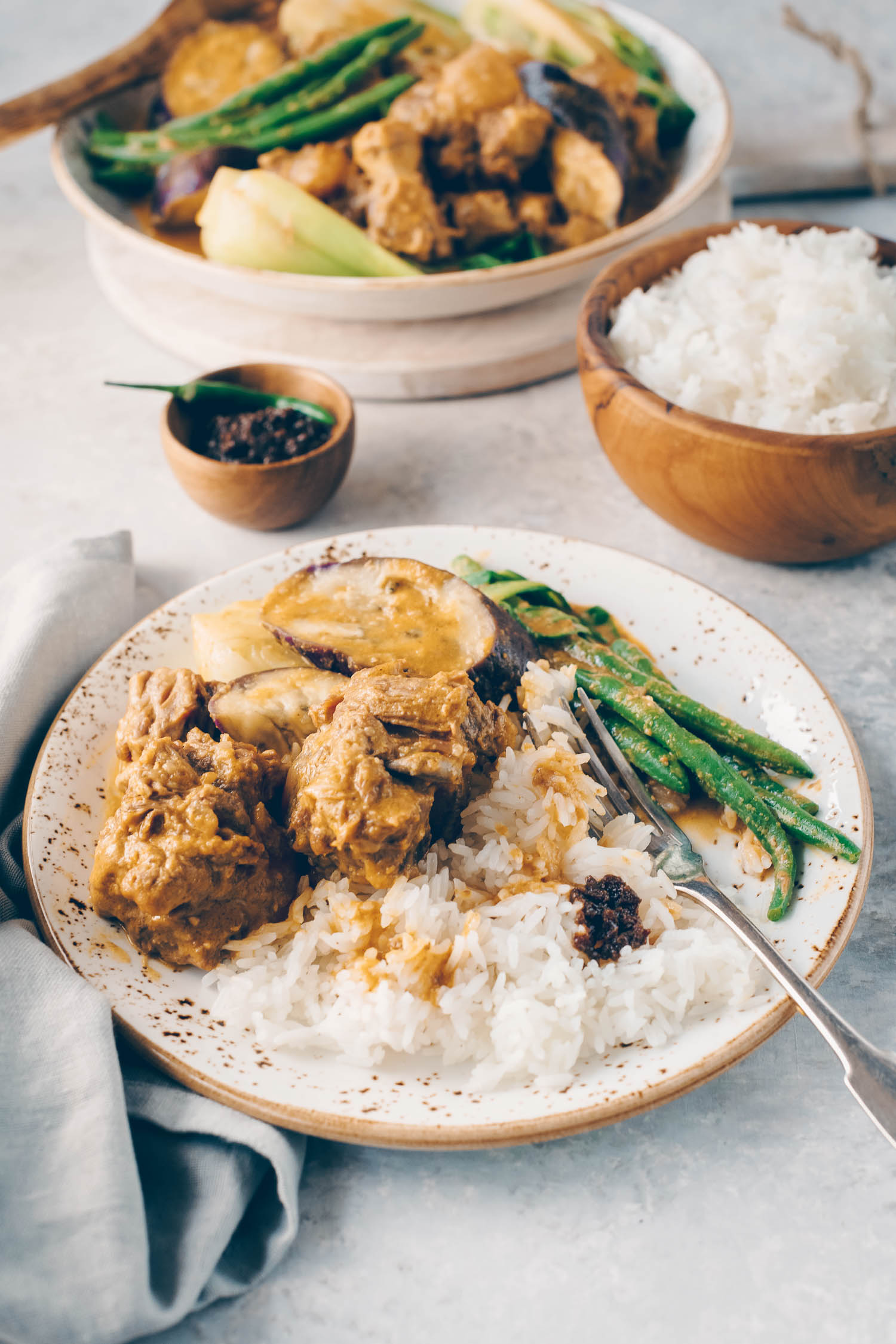
My Kare-Kare
Skim the Fat: I broke up the cooking process over two days though this is optional. Oxtail is a fatty cut of meat and I wanted to skim most of this fat before finishing the dish. I pressure cooked the oxtail and refrigerated it overnight, allowing me to skim one cup of fat the next day. I did leave two or three tablespoons in the stock to help preserve the flavor and to offset the creaminess of the peanuts that would be added later. This step is completely optional but it did free me from the guilt of indulging in this dish two days in a row.
Vegetables: For the vegetables I used popular substitutions in the absence of banana blossoms and string beans (Chinese long beans). Bok choy and regular green beans work just as well here. Eggplants are a must.
Crushed Peanuts: Peanut butter is much more convenient to use instead of crushing peanuts with a mortar and pestle. I do prefer to use natural peanut butter instead of Jif and Skippy to avoid additives but it wouldn’t be a deal breaker if these are your peanut butter go-tos.
Ground, Toasted Rice: While I used ground, toasted raw rice for my recipe, this step is optional. My mother doesn’t even bother with this step and I consider her the authority on Filipino food. The rice serves as a thickener for the stew but the peanut butter thickens the stew, too. Feel free to skip this step.
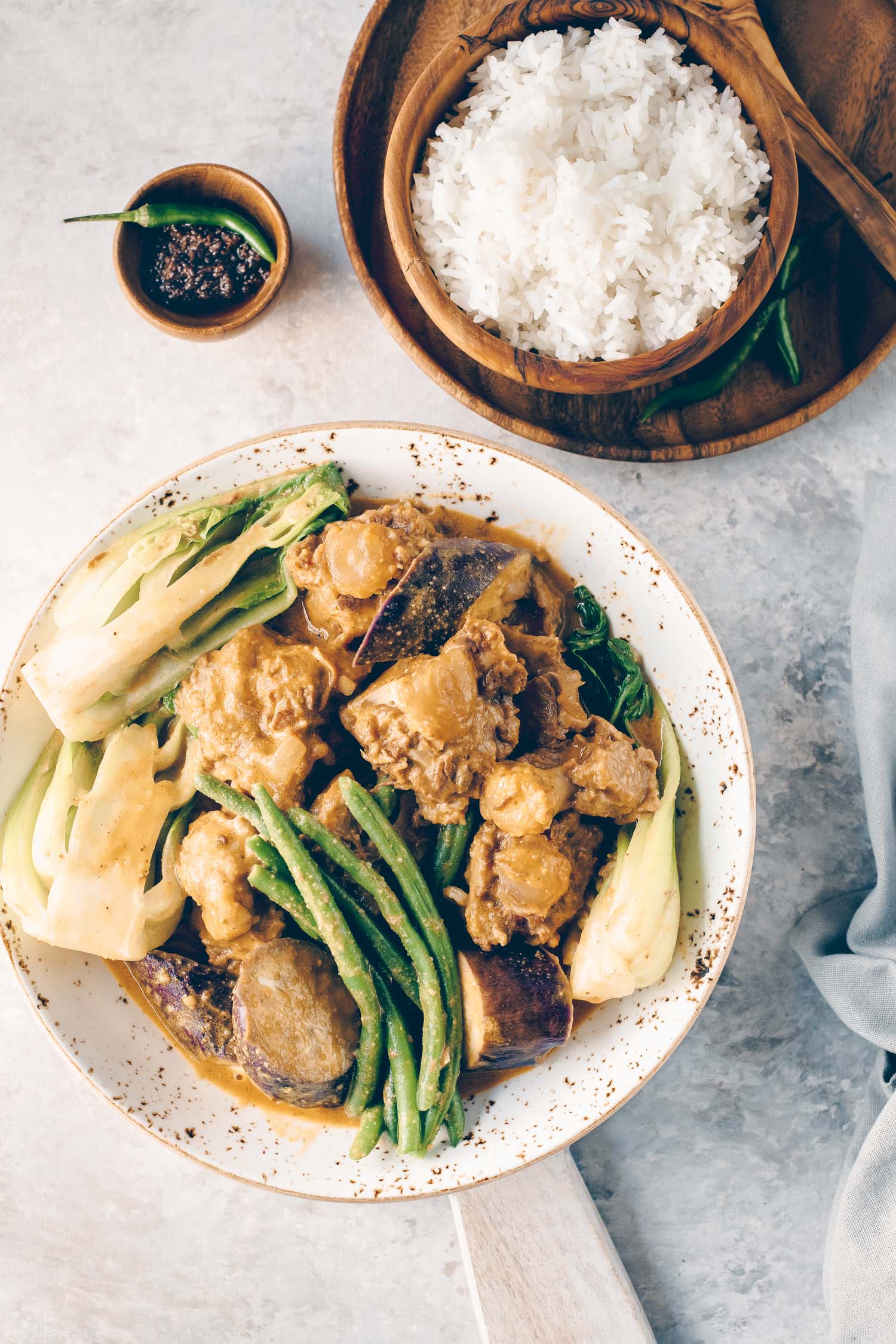
This dish has been a long time coming. With my household of two it has not always been practical to share some of my favorite Filipino dishes as they are typically cooked in family-size portions. But as I prepare to greet the ninth anniversary of this blog in a few days I’m more committed than ever to share with (and hopefully educate) my readers traditional Filipino cuisine. With all the regional specialties and being familiar with only the food of my childhood, I’m learning, too, as I go. This kare-kare is just one step forward in this journey.
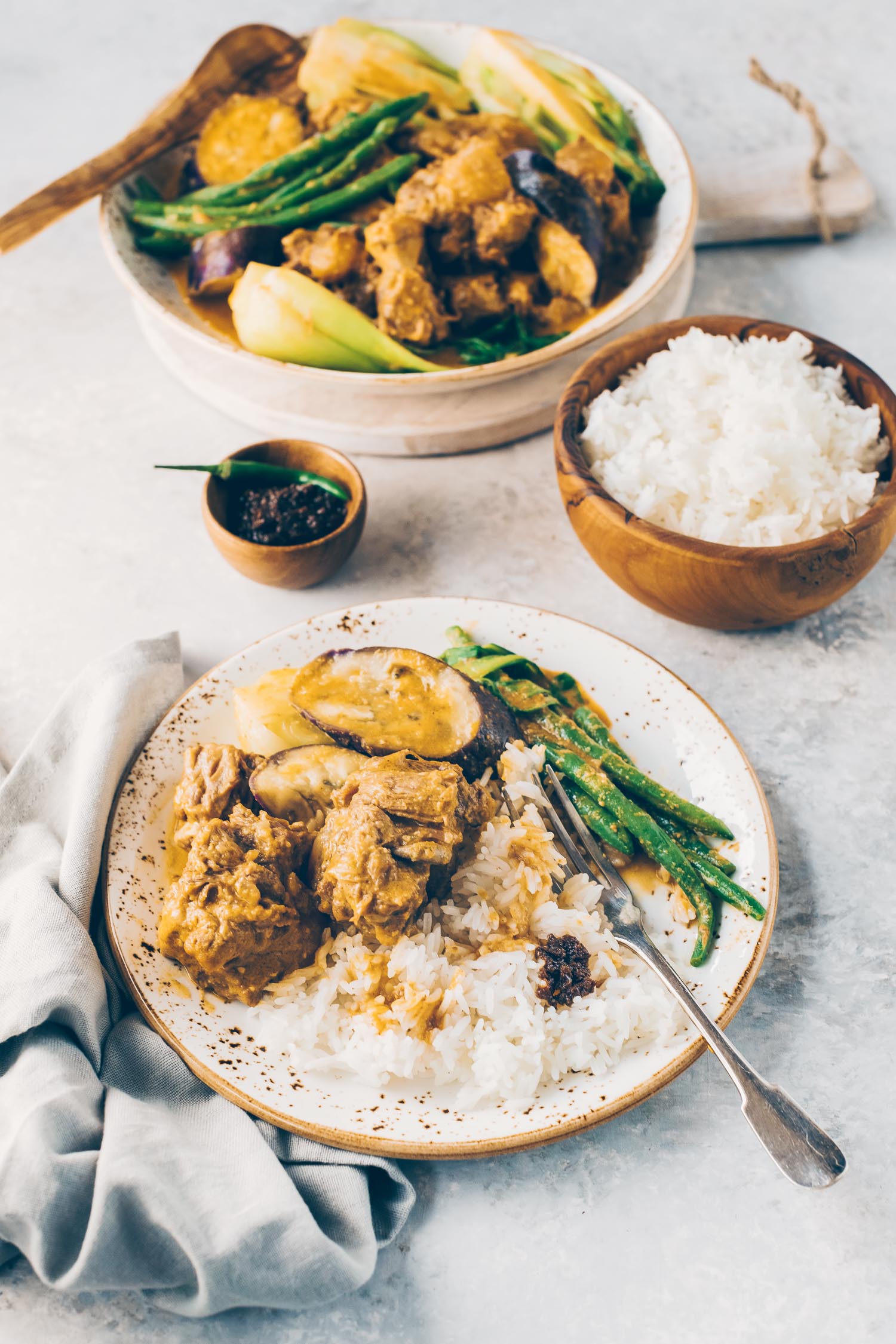

Instant Pot Kare-Kare (Filipino Oxtail-Peanut Stew)
Kare-kare is an oxtail stew with a peanut base. It’s a Filipino classic with a long cooking time but the Instant Pot will have it ready in half the time.
Ingredients
- 3 pounds oxtail
- 5 cups water
- 1 teaspoon onion powder (not onion salt)
- 1 teaspoon kosher salt
- 1 onion, chopped
- 1 tablespoon fish sauce
- 3/4-1 cup peanut butter (See Note)
- 1 large Chinese eggplant, sliced one-inch thick
- Thick handful of green beans
- 4 stalks bok choy
- 1/4 cup annatto seeds soaked in 1/2 cup of the warm oxtail broth (optional)
- 1 tablespoon raw white rice, ground in a spice grinder (optional)
- 2 tablespoons olive oil
- Shrimp paste for serving on the side
Instructions
Pressure Cook the Oxtail
-
Combine in your Instant Pot the oxtail, five cups of water, onion powder and kosher salt. Pressure cook for 35 minutes and natural pressure release (NPR) for 10 minutes.
-
If you plan to skim some of the fat from the broth (I skimmed all but two to three tablespoons), let the broth and meat cool then refrigerate overnight. Skim as much fat as you want to remove the next day before continuing with the cooking process. If you don’t wish to skim any of the fat, continue to the next step.
-
Note: Since I cooked the dish entirely in the Instant Pot I transferred the meat and broth to another container and cleaned out the stainless IP bowl before continuing to the sauté stage.
Assemble the Kare-Kare
-
Blanch the eggplant, green beans and bok choy and set aside.
-
Using the stove top or Instant Pot (using the sauté mode) sauté the onion in the olive oil over medium heat. Add the fish sauce followed by 1/2 cup of oxtail broth infused with the annatto seeds (strain the seeds and discard–you don’t add the seeds to the kare-kare). Add the oxtail and three cups of the oxtail broth and bring to a simmer.
-
Stir 3/4 cup of the peanut butter into another 1 cup of the reserved broth (remember we cooked with five cups of water) and add this to the pot. If you're using the ground rice you can add it at this time. Stir to fully incorporate the peanut butter into the stew. Taste and decide if you need to add the last 1/4 cup of peanut butter and/or more fish sauce. Add the blanched vegetables and serve with steamed white rice and shrimp paste.
Recipe Notes
Peanut Butter: Start with 3/4 cup peanut butter and taste before adding the last 1/4 cup. Since I skimmed most of the fat from my oxtail broth I didn’t need a full 1 cup. Adjust according to your preference.
Oxtail Broth: Cooking the oxtail in five cups of water will leave you with roughly 4 1/2 cups of broth after you skim the solidified fat. You will need all of this for the final product: 3 cups to add to the pot, 1 cup to stir into the peanut butter and 1/2 cup to infuse with annatto seeds.






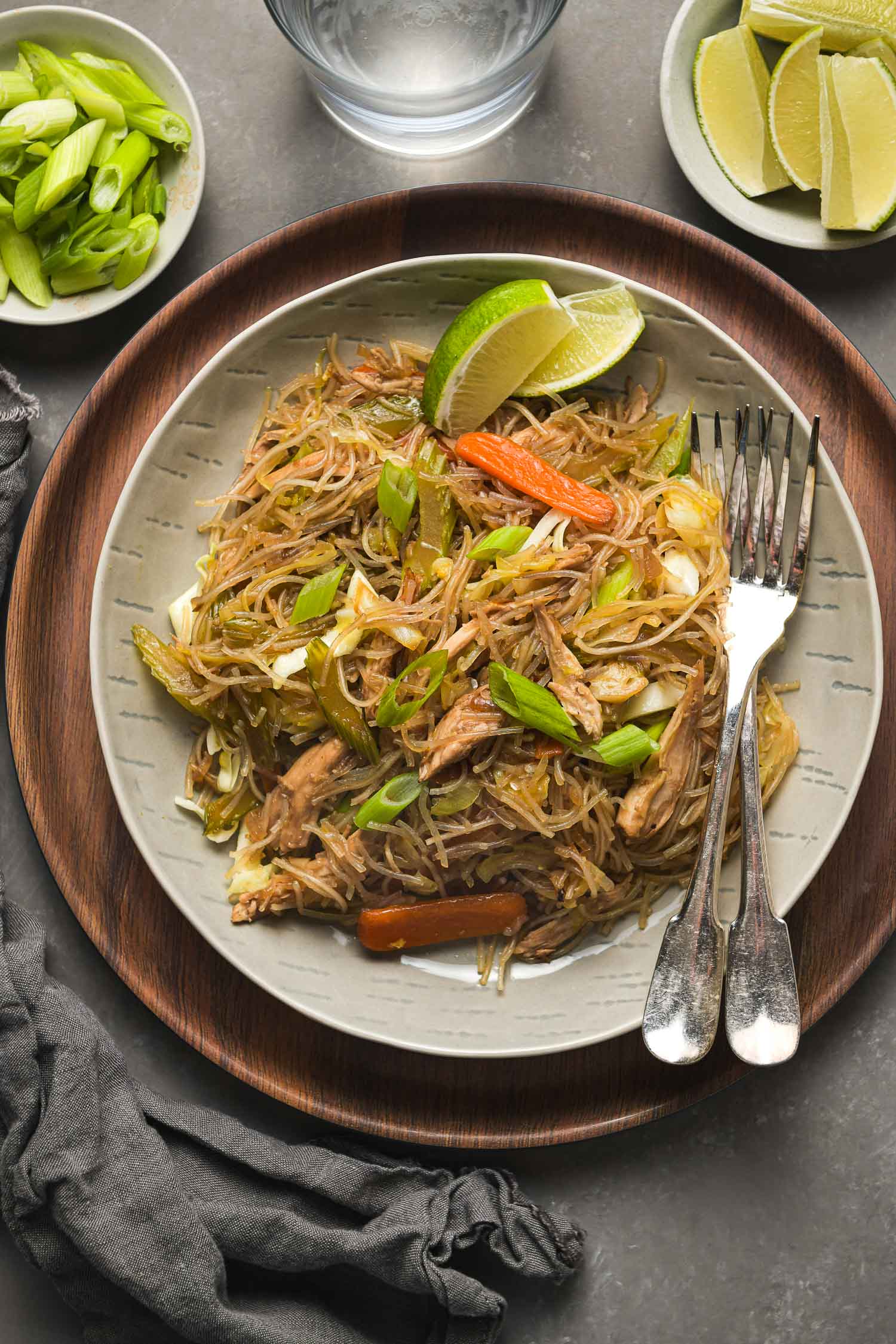



Hi
I appreciate your blog which i just found today. Thanks for sharing all these.
Looks like there’s a lot involved with Kare kare. Do you happen to have this on YouTube?
Thank you
Hi, Jean! Always Nice to meet another namesake. 🙂 Kare Kare actually seems laborious but it’s really not, especially using a pressure cooker. Once the meat has been cooked in the pressure cooker it’s just a matter of simmering the rest of the ingredients. I haven’t ventured into videos but plan to one day. Hope you like this recipe if you try it. 🙂
Absolutely delicious AND super easy! It was a total hit! This is now my go to recipe for Kare Kare. Thank you so much for sharing!
This is so nice to hear!! Thank you for trying my recipe and I’m so glad you liked it. 🙂
You never mention when to add the crush peanuts or toasted rice?
Hi, there. You can add the toasted rice at the same time as the peanut butter. Regarding the crushed peanuts, I use natural peanut butter instead but you can stir them in in Step 3 when you assemble the Kare kare in my instructions (where I use peanut butter you can follow instructions using crushed peanuts). I’ve made the update–thanks for letting me know about the oversight. 🙂
Hi there! I will try this and use almond butter instead of peanut butter. My kids are allergic to peanuts and I do not want them to miss this out.
Hi, Aimee. That’s great. I haven’t tried it myself but I’ve heard that using almond butter will taste just like peanut butter. Please let me know how it goes. 🙂
Hi Jean,
Thank you very much for the fantastic recipe! It is delicious! It’s so easy to make and the final kare-kare is rich in flavor. It reminds me of my Lola and brings me back to my childhood. I love it! Thanks again!
Trisha, thank you so much! So glad you enjoyed this kare-kare recipe and I really appreciate your taking the time to give me feedback. 🙂
Hello!
If I want to add in tripe, should I pressure cook it with the oxtail? Thanks!
Hi, Anna. I haven’t ever pressure-cooked tripe so I can’t advise you unfortunately. If you find that the cook time is the same as ox tail then I would say you can do them together. Sorry I’m not more help.
I don’t eat kare-kare but my husband loves it. I followed your recipe to the letter and it was a hit! Thank you for sharing this!
I’m so happy to hear this, thank you so much for trying the recipe and your feedback. So glad your husband liked it. 🙂
I dont have the seeds to soak in the water for the color, but i have the powder. How much powder would I use? First time for me to make this for my Filipino friends and it is a surprise. I hope it turns out good.
Hi, Shirley. Did you end up using the powder for this recipe? I would try a half to one teaspoon to start and if you achieve the color you are after. You can always add more. Hope this helps. 🙂
This was my first time making kare kare AND first time using my instant pot, so I must admit I was a little intimidated. I thought this was going to be a challenge but I was sooo wrong. I’m Filipino and this is one of the best kare kares I’ve had. My boyfriend said it was his favorite!! I followed the recipe exactly and I couldn’t be happier. A million thanks
Marie
Wow, Marie, how wonderful to hear this. Congrats on making Kare-kare for the first time–I was intimidated, too, so I understand. So glad this recipe worked for you–thank you so much for giving it a chance. 🙂
Thank you for this recipe!! I’ve been wanting to cook kare-kare since two years ago! I never cooked oxtail before, so I’m glad I found an Instant Pot version. 🙂
Cooked it tonight, recipe was easy to follow! And my American husband loved it!
Yay, so glad this recipe worked out for you, Char, and even better that your husband loved it! Thanks so much for the nice feedback!
I’m interested in making this. I have beef brisket in the freezer, do you think that cut of beef is ok to use for this recipe? Also, can I use beef bouillon instead of oxtail broth?
Hi, Marc. I don’t have any experience with brisket but after looking it up, I’d say yes, it should work for this recipe. You can also use beef bouillon though I’d say with these substitutions you might not achieve the same richness as you would using oxtail. Since I tend to skim most of the fat off the stock here, I’d say it’s worth a try. If you do give this recipe a go, I’d love to know how it turns out. Thanks so much for your interest. 🙂
Hi. Thanks for this recipe! What do you mean by blanching the eggplant, bok choy, and green beans? Could you explain the process please? Thank you!
Hi, Mel. To blanch the vegetables is to quickly cook them in boiling water (or steam) just long enough so they don’t wilt or lose their color. You can cook them right in the kare kare, too, so feel free to proceed in a way that’s more convenient for you. Hope this helps.